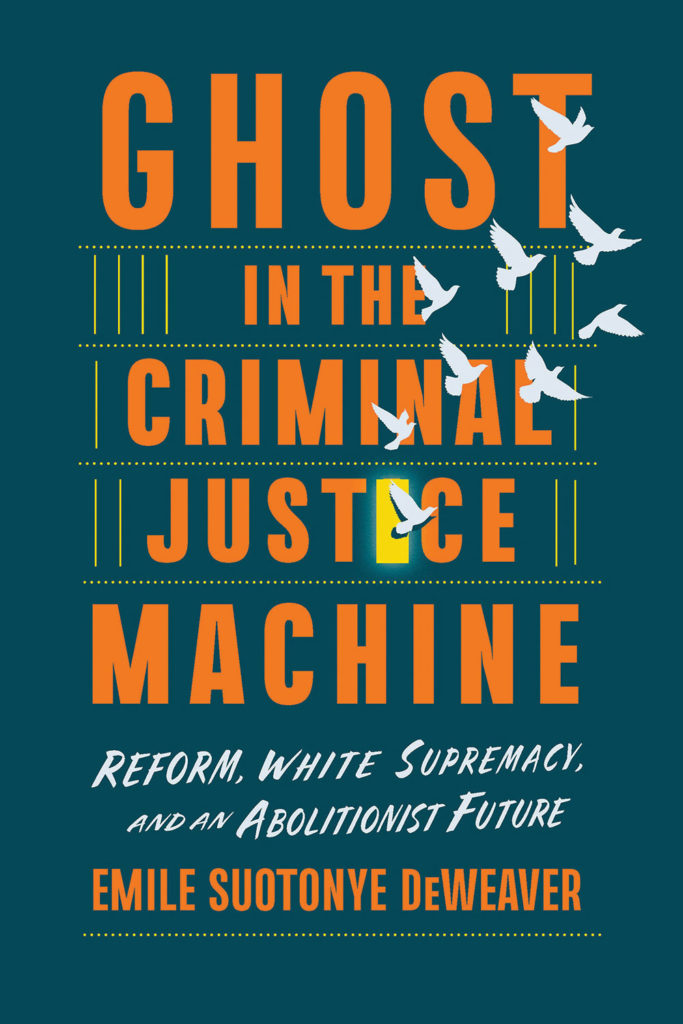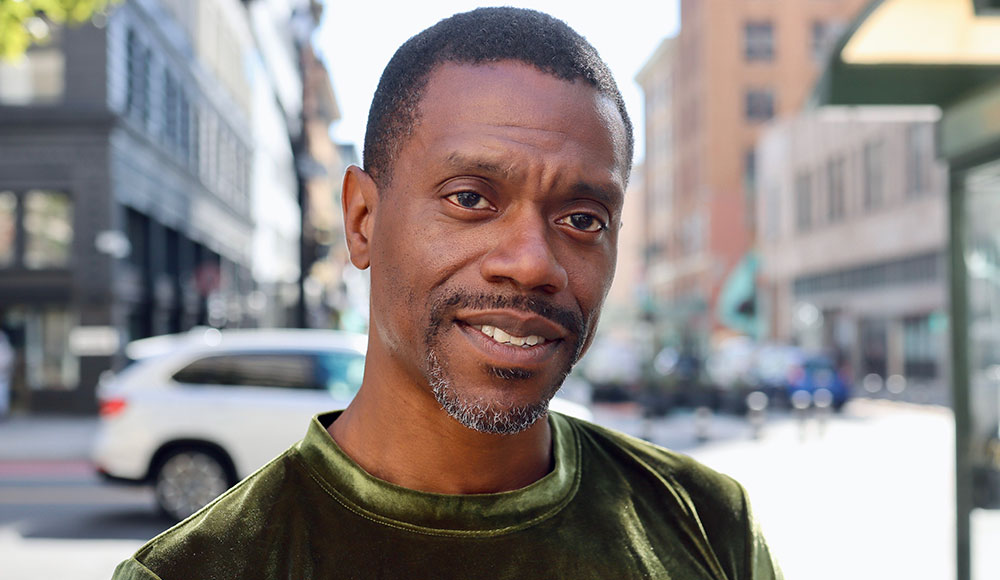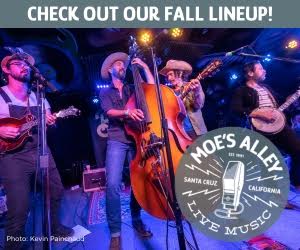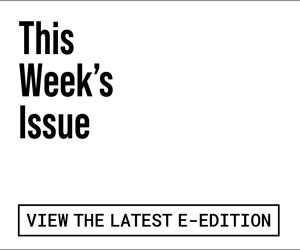Emile Suotonye DeWeaver became an activist and journalist while incarcerated for 21 years and cofounded the organization Prison Renaissance. Ghost in the Criminal Justice Machine: Reform, White Supremacy and an Abolitionist Future is DeWeaver’s new book, which envisions a culture without white supremacy, where police and prisons are replaced with healing systems that create safety and accountability. He will be reading from his book on July 18 at the UC Santa Cruz Institute of the Arts and Sciences.
WHITE IS A METAPHOR FOR POWER
John Malkin: You write, “Police work for the white supremacist status quo that was established at the founding of this country.”
Emile DeWeaver: When I’m talking about white supremacy I like to start with the quote by James Baldwin. He says that white is not a skin color; it’s a metaphor for power. A failure to understand that is really connected to the shame spirals we find ourselves in around white supremacy, particularly amongst white people. And also the blind spots, particularly amongst non-white people, about the ways we participate in white supremacy as a survival strategy.
I think about white supremacy in three terms. We’re familiar with the impacts of white supremacy on an individualism level, like “I’m discriminated against” or “I’m pulled over by the police.” And we’re familiar with the structural components of white supremacy like court systems, laws and redlining.
These are important, but what goes missing is the culture and ideology of white supremacy, which are really the things we need to focus in on because the structures of white supremacy just enforce the culture. If you dismantle the structures, the culture would just breed new mechanisms to enforce itself. Ultimately we need to kill the culture, but we must understand that culture is just normalized ideology.
If we want to really start dealing with the root causes of white supremacy we need to understand that we have all been taught to be white supremacist. There’s so many ideas on this from The New Jim Crow all the way to Afro-pessimism that give us the structural manifestations of white supremacy. Often in the culture of white supremacy the thing that signals you’re safe is that you’ve adopted the culture. You’ve joined the ranks of structural Stockholm Syndrome; you’ve taken on the values and mores of your oppressor.
WRITE MY WAY OUT
You write, “By the age of 18, I was serving 69 years to life for murder. By 19, I experienced an awakening and resolved to write my way out of prison.” Tell me about your awakening and your resolve to write your way out of prison.
I always like to say, “You do realize I was a child when I went to prison? So, primarily I grew up.” Probably the biggest factor was that at 19 I was forced to grow up because I had a child. My daughter was born and I met them behind a glass wall. I started thinking about what my daughter was going to see as they grew up, which forced me to look at myself. What they were going to see was a junior high school dropout and someone who, in our society, is a murderer, a throwaway and something to be ashamed of. From my pretty rough relationship with my father, I knew there was no way for my kid to grow up feeling ashamed of me without also being ashamed of themselves. And that cracked me in half.
The little seed of hope was, “Starting right now, you are going to become someone that your kid can be proud of.” I resolved to write my way out of prison. But plan B was, “If I never get out of prison, I can still live a life that shows my kid that no matter how far you fall down, you can always turn around and build something beautiful in your life. That was my wake-up moment. I didn’t have the training to be a writer, so I spent the next 12 years training myself through reading, practice and handwritten rejection letters from editors, honing my craft until I got to a place where I could make a living writing.

QUIET PACIFISM
You write that while incarcerated, you practiced “quiet pacifism” and “meditated like a Zen monk.”
It’s accurate to say that meditation, if it didn’t save my life, it saved my sanity. I came to meditation through practicing Tai Chi in prison. I was also reading the journals of Ralph Waldo Emerson. He had this one line—“Write your own Bible”—and it blew my mind. I was like, “What? You can do that?” So, I began to write my own Bible and 12 years later I came across Buddhism and I realized, “This is what I thought I created!” I got really deep into Buddhist compassion practices, the four noble truths, eightfold path and with that came a commitment not to harm people. There’s a lot of strategy that goes into living in very violent prisons where violence is the currency that earns respect. So I say “quiet pacifist” because it’s not like I was on the yard saying, “Hey everyone, I’m a pacifist!” But I was always strategizing so as to resolve all problems without violence.
I was interested to read in your book, “My dream for abolitionists who will not engage reforms is that they soften the hard lines of this stance.” You also write, “For abolition to work, it must be led not by incarcerated people’s families, not by formerly incarcerated people, but by incarcerated people.”
There is the general concept that impacted people should lead the work. One of the reasons I founded Prison Renaissance is because there was this accepted norm that incarcerated people can’t create organizations because they’re in prison. I saw that as an imagination problem. I founded Prison Renaissance to break that imagination lock.
It was founded and run by incarcerated people, even in a situation where incarcerated people are not allowed to run nonprofits. That was a very dicey time! But, we did it! We’d be in college classrooms, lecturing over the phone. We did a live art event with Southern Exposure in San Francisco called Metropolis with recordings of incarcerated people telling stories about their experiences. I called in and facilitated a town hall-style meeting around emergent strategy and abolition. People’s minds were blown.
There’s no reason why more effort isn’t put into building incarcerated leadership. Think about the Civil Rights movement and imagine the entire country marching across the bridge at Selma but all the Black people stayed home. Could we have had a civil rights movement? Of course not. So, why do we think it’s different for abolition?
Tell me more about prison reforms you see as necessary.
What do reforms look like that give incarcerated people more protection and power? The golden standard for me is prison slave labor. Step one is a reform campaign that’s banning slave labor. Step two, getting it enforced. Step three, while you’re getting it enforced we’re building the right for incarcerated people to own their labor. Incarcerated people work for companies for more money than they would make in prison, but it’s a quarter of what they would make if they were out of prison. But that makes up such a small minority of prison labor. Ninety-plus percent of prison labor is slave labor running the prison: electricians, janitors, cooks, servers, secretaries. Prisons today are simply not sustainable without slave labor. And that’s the importance of ending slave labor! The gears would grind themselves out. So, I wish there was a softer line on reforms and a more strategic approach.
When you describe the right for incarcerated people to own their work, it reminds me of exploitation that occurs outside of prison.
What defines slavery is choice. Where we live in capitalism, you cannot choose not to work. Prison is just the clearest manifestation of our society. This same shit playing out in prison is playing out with you at home watching TV, going to work. I ask people, “Tell me you don’t feel disposable in your country as a white person who doesn’t want to make any waves because you know how quickly you will be disposed of by the very system you are riding on right now!” You can think of prison as a machine, a mechanism of disposability, and if you trace that to its root you will find white supremacy.
HEALING CITIES
A central question in your book is; what does a world look like where we don’t put people in prison for breaking laws, even when someone commits a violent act? Tell me about your concept of healing cities and harm recovery programs where “men weep when they hurt” and learn to use power in healthy ways.
The idea for the healing cities comes from thinking about how much money we spend on prisons and police. I did the math and we can solve three of our major social problems by not spending it on police and prisons. There could be no homelessness and everyone could have an education with no debt. I’m a hippie! I was raised in California and I go to festivals where we’re basically creating entire cities over a weekend and then dismantling them at the end of the week. We are our own government. Harm happens in these places and we have processes for holding people accountable and restoring safety.
So, these structures that abolitionists are trying to promote, they already exist. They just don’t exist for Black people! In my hippie world, it’s a lot of white people. Healing cities is an act of visionary fiction. Let it be a starting point for a conversation as we all collectively figure this out.
DEFUND THE POLICE
We just marked the fifth anniversary since George Floyd was killed by Minneapolis police on May 25, 2020. Black Lives Matter and Defund the Police were huge movements worldwide. When I ask people, “What happened to Defund?” many say, “It collapsed because the word defund was just too much for people.” What do you think happened to Defund?
It was not the word chosen for the project! (Laughs.) What happened to Defund the Police is that people don’t understand how they’re impacted by propaganda in the 21st century. It approaches mind control. The science of it is so tight but there’s not enough humility in our movements to understand and engage that. Now we’ve missed the bus. This guy got elected and a lot of people are screaming, “I want to get involved.” And it’s like, “I’m sorry to break it to you but the time to get involved was before he got elected.”
This is an “I told you so” moment but it’s also a “frameworks and principles” moment. Principle one: we got outmaneuvered. Principle two: if you’ve been out-maneuvered that means you’re two steps behind. Principle three: the worst thing you can do if you are two steps behind is rush forward; they’ve already prepared their response to what we’re going to do. Principle four: it is vital for us to stop and pause. Inaction is also a strategy. Bayo Akomolafe says, “Times are urgent, let us slow down.”
For me, clarity is hope. Clarity is the only foundation on which you can build power that belongs to you. Power is the only thing that can change this world. So, I invite people to engage these difficult topics with the mindset that the clearer you get, the more powerful you become. And the more powerful you become, the more hope we have.
Emile Suotonye DeWeaver speaks at 6pm on July 18 at the UC Santa Cruz Institute of the Arts and Sciences, 100 Panetta Ave, Santa Cruz. ias.ucsc.edu
Listen to this interview with Emile DeWeaver on Thursday at noon on “Transformation Highway” with John Malkin on KZSC 88.1 FM / kzsc.org.












